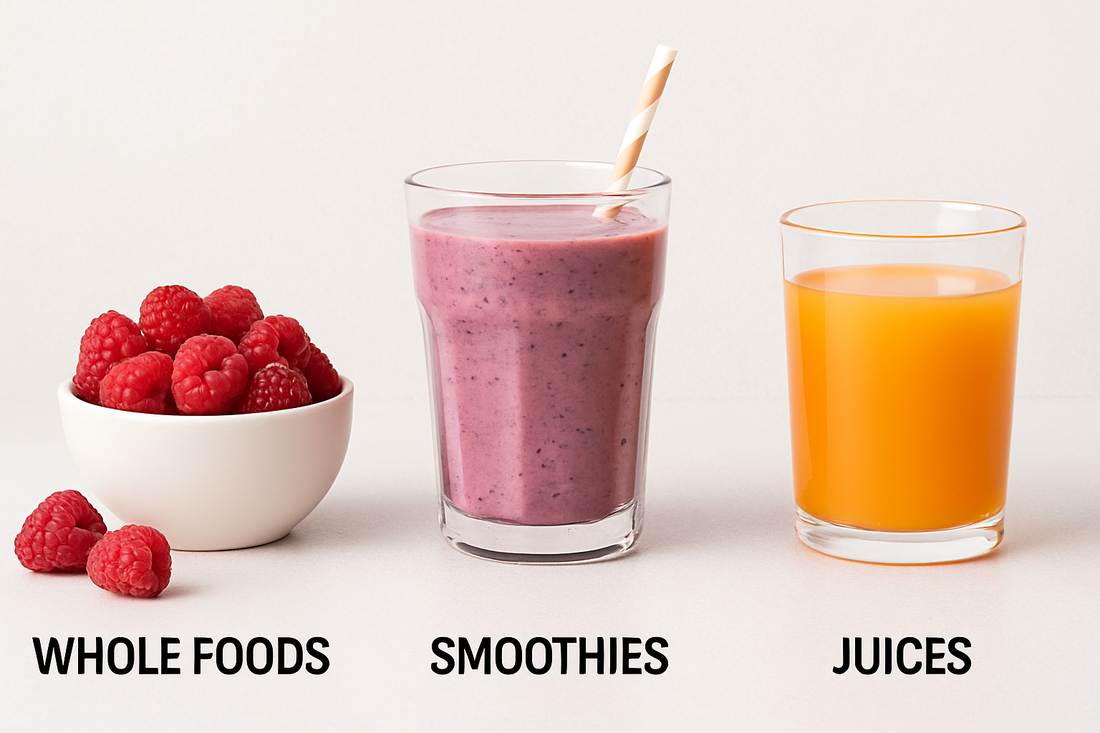
Whole-foods, Smoothies, or Juices?
Share
Whole Foods, Smoothies, or Juices: Why Structure Matters
At KOYAH, our passion is helping you get your fruits and vegetables in their most nutritious form. One important distinction we often talk about is the difference between eating a whole food, blending a smoothie, and drinking juice. While all three can deliver nutrients, how your body processes them is very different — and it all comes down to structure.
What Is a Whole Food?
A whole food is a food that remains as close as possible to its natural state. Fresh fruits, vegetables, nuts, seeds, and whole grains are all examples. In a whole food, the fiber, cell walls, and natural nutrient structure are fully intact. This structure is critical for how your body digests and absorbs nutrients.
Smoothies: A Form of Whole Food
When you blend a fruit or vegetable into a smoothie, you mechanically break it down — but you still retain all parts of the original food, including the fiber, nutrients, and beneficial compounds. Smoothies are considered a form of whole food because they include the entire fruit or vegetable, simply blended into smaller pieces.
Research shows that smoothies slow digestion compared to juices, helping to regulate blood sugar levels and maintain feelings of fullness1. While blending slightly disrupts the food's structure, smoothies still deliver the complete nutrition that nature intended.
Juices: Missing the Whole Picture
Juicing, by contrast, removes the fiber and much of the plant’s natural structure. What remains is a liquid rich in sugars and some water soluble vitamins, but lacking the fiber that helps regulate digestion, blood sugar, and appetite. Without the fiber, juice can cause faster spikes in blood sugar and does not promote the same feeling of fullness as whole fruits, vegetables, or smoothies.
Studies have shown that whole fruits and smoothies support healthier blood sugar responses and greater satiety compared to juices2.
Freeze-Dried Powders: Like a Smoothie, but Shelf-Stable
At KOYAH, we freeze-dry whole fruits and vegetables and grind them into powders without removing any fiber or nutrients. Just like blending a smoothie, freeze-drying and grinding simply break the food into smaller pieces — all the nutrition stays intact.
The result is a convenient, shelf-stable powder that delivers the benefits of whole food nutrition without the need for refrigeration or immediate consumption. It's like having a smoothie you can keep on the shelf — still 100% whole food, just in a different form.
Why Structure Matters
The natural structure of a whole food controls how quickly sugars, antioxidants, and other nutrients are released during digestion. When you eat whole foods — whether fresh, blended into a smoothie, or preserved through freeze-drying — you allow your body to absorb nutrients at a natural, healthy pace.
Removing this structure, as in juices, delivers a flood of sugars and nutrients all at once, which can overwhelm the body's natural regulatory systems over time.
KOYAH: True Whole Food Nutrition
We believe the best nutrition comes from organic, whole, minimally processed foods. That's why KOYAH products are made from 100% whole fruits and vegetables — freeze-dried to preserve their nutrients and structure, then ground into convenient powders with no fillers, no additives, and no juices or extracts.
Whether you're eating fresh raspberries, blending a smoothie, or using a KOYAH freeze-dried raspberry powder, preserving the integrity of the whole plant makes all the difference for your health.






